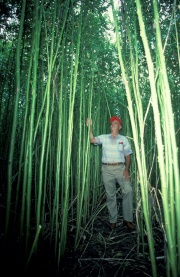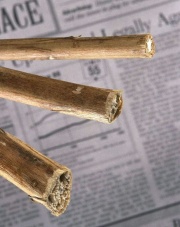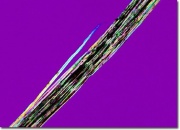Difference between revisions of "Kenaf"
(username removed) |
(username removed) |
||
| Line 17: | Line 17: | ||
== Additional Information == | == Additional Information == | ||
| − | G.Cook, ''Handbook of Textile Fibres:I. Natural Fibres'', 5th edition, Merrow Publishing Co., Durham, England, 1984. | + | ° G.Cook, ''Handbook of Textile Fibres:I. Natural Fibres'', 5th edition, Merrow Publishing Co., Durham, England, 1984. |
[[File:kenafbastlarge.jpg|thumb|Kenaf fiber]] | [[File:kenafbastlarge.jpg|thumb|Kenaf fiber]] | ||
| Line 28: | Line 28: | ||
== Authority == | == Authority == | ||
| − | * | + | * J.Gordon Cook, ''Handbook of Textile Fibres:I Natural Fibres'', Merrow Publishing Co. , Durham, England, 1984 Comment: H. cannabinus |
* ''Fairchild's Dictionary of Textiles'', Phyllis G.Tortora, Robert S. Merkel (eds.), Fairchild Publications, New York City, 7th edition, 1996 Comment: H. cannabinus | * ''Fairchild's Dictionary of Textiles'', Phyllis G.Tortora, Robert S. Merkel (eds.), Fairchild Publications, New York City, 7th edition, 1996 Comment: H. cannabinus | ||
| − | * | + | * Marjory L. Joseph, ''Introductory Textile Science'', Holt, Rinehart and Winston, Fort Worth, TX, 1986 |
| − | * ''Encyclopedia Britannica'', http://www.britannica.com Comment: "Kenaf." | + | * ''Encyclopedia Britannica'', http://www.britannica.com Comment: "Kenaf." Encyclopædia Britannica. 2 Sept. 2004 . H. cannabinus |
* Wikipedia, the free encyclopedia, at http://www.wikipedia.com Comment: http://en.wikipedia.org/wiki/Kenaf (Accessed Nov. 9, 2005) | * Wikipedia, the free encyclopedia, at http://www.wikipedia.com Comment: http://en.wikipedia.org/wiki/Kenaf (Accessed Nov. 9, 2005) | ||
| − | * | + | * Website address 1 Comment: Olympus Microscopy Resource Center at http://www.olympusmicro.com/galleries/polarizedlight/pages/kenafbastsmall.html - introduced to Europe in the late 1700s |
| − | * | + | * G.S.Brady, ''Materials Handbook'', McGraw-Hill Book Co., New York, 1971 Comment: p. 427; Hibiscus sabdariffa |
| − | * | + | * Richard S. Lewis, ''Hawley's Condensed Chemical Dictionary'', Van Nostrand Reinhold, New York, 10th ed., 1993 |
| − | * | + | * Random House, ''Webster's Encyclopedic Unabridged Dictionary of the English Language'', Grammercy Book, New York, 1997 Comment: H. cannabinus |
* Art and Architecture Thesaurus Online, http://www.getty.edu/research/tools/vocabulary/aat/, J. Paul Getty Trust, Los Angeles, 2000 | * Art and Architecture Thesaurus Online, http://www.getty.edu/research/tools/vocabulary/aat/, J. Paul Getty Trust, Los Angeles, 2000 | ||
Revision as of 06:37, 24 July 2013
Description
Bast fibers obtained from the stems of the fast-growing Hibiscus cannabinus plant. The plant is found throughout the world and the fibers have a wide variety of names: It is called paco-paco in South America; Java jute in Indonesia; and Billipatam jute, sunee, brown Indian hemp, Deccan hemp in India. Kenaf fibers were introduced to Europe in the late 18th century, but did not become widely used until the 20th century. Kenaf is a light colored fiber that is resistant to water. It is similar to jute and was used as a substitute during World War II. Kenaf is still used in burlap coffee bags and for ropes and cords. The woody core of the plant is used in paper products and particleboard. The oil from kenaf seeds is used for lamps.
Synonyms and Related Terms
Hibiscus cannabus; mesta (India); meshta; Guinea hemp; Deccan hemp (India); Java jute (Indonesia); paco-paco (South America); ambary hemp; ambari hemp; awasthe hemp; bimli patam; bimli jute (India); gambo hemp; gombo hemp; Billipatam jute (India); sunee (India); brown Indian hemp (India); kenaf (Esp.); kenaf= javajute, deccanhennep (levert juteachtige vezel) (Ned);
Other Properties
Plant height = 1.5-3.5 m with woody base Stems=1-2 cm in diameter. Leaves=lobed (10-15 cm long) Fruit = capsule (2 cm) containing several seeds Fiber cross section = polygonal
Additional Information
° G.Cook, Handbook of Textile Fibres:I. Natural Fibres, 5th edition, Merrow Publishing Co., Durham, England, 1984.
Comparisons
Authority
- J.Gordon Cook, Handbook of Textile Fibres:I Natural Fibres, Merrow Publishing Co. , Durham, England, 1984 Comment: H. cannabinus
- Fairchild's Dictionary of Textiles, Phyllis G.Tortora, Robert S. Merkel (eds.), Fairchild Publications, New York City, 7th edition, 1996 Comment: H. cannabinus
- Marjory L. Joseph, Introductory Textile Science, Holt, Rinehart and Winston, Fort Worth, TX, 1986
- Encyclopedia Britannica, http://www.britannica.com Comment: "Kenaf." Encyclopædia Britannica. 2 Sept. 2004 . H. cannabinus
- Wikipedia, the free encyclopedia, at http://www.wikipedia.com Comment: http://en.wikipedia.org/wiki/Kenaf (Accessed Nov. 9, 2005)
- Website address 1 Comment: Olympus Microscopy Resource Center at http://www.olympusmicro.com/galleries/polarizedlight/pages/kenafbastsmall.html - introduced to Europe in the late 1700s
- G.S.Brady, Materials Handbook, McGraw-Hill Book Co., New York, 1971 Comment: p. 427; Hibiscus sabdariffa
- Richard S. Lewis, Hawley's Condensed Chemical Dictionary, Van Nostrand Reinhold, New York, 10th ed., 1993
- Random House, Webster's Encyclopedic Unabridged Dictionary of the English Language, Grammercy Book, New York, 1997 Comment: H. cannabinus
- Art and Architecture Thesaurus Online, http://www.getty.edu/research/tools/vocabulary/aat/, J. Paul Getty Trust, Los Angeles, 2000


